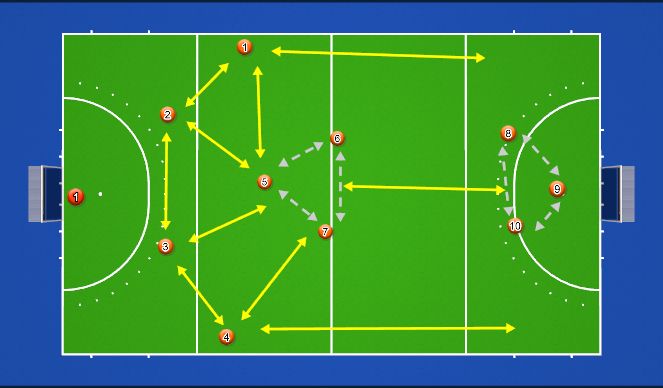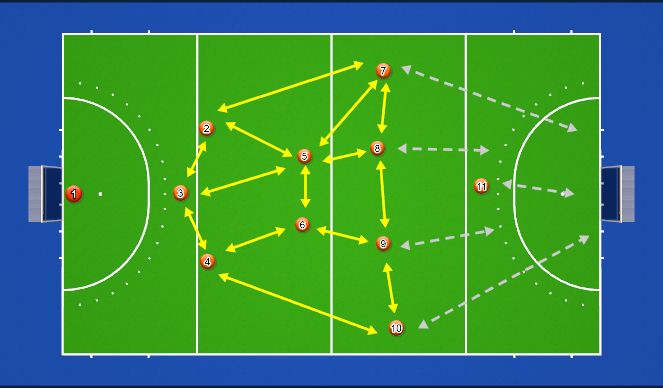Hockey Session (Senior): Formations
Profile Summary

| Name: | Robert Dent |
|---|---|
| City: | Cheltenham |
| Country: | United Kingdom |
| Membership: | Adult Member |
| Sport: | Hockey |
Description
Focus: Different playing structures and roles.
A way to mix up playing formation to challenge the opposition as this will change the outlet patterns and options available, but also start to make them think deeper about who they should be marking.
An explanation of each player's role will be accompanied on each formation slide.

See the guidance at the top of this page to understand why you are not seeing interactive Hockey images.

4-3-3
1+4: Wide defenders/Half. Give the outlet width and intention to attack wide by dragging out the opposition press. Aim to get on the gain line of the striker that's marking you in a press.
2+3: Central defenders. Remain fairly central and near 15m apart to act as counter cover when the ball is in attacking half. Looking to connect with midfielders and Halves. But also look to perform overheads to the forwards.
5+6+7: Midfielders. Should be looking to play together, lots of passes between each other and rotating to post up and lead to receive passes from the defenders. Create link between the defence and strikers. Not always a left/middle/right partnership, but can help in less experienced teams (but I do find this often limits passing options from an outlet so should be able to rotate through).
8+9+10: Strikers/Forwards. Again, not necessarily a left/middle/right partnership, but looking to lead off each other. If one leads to the T spot, then another leads to back post and guard pass. Don't run in isolation of each other and should expect to be doing LOTS of unselfish leading. You may get the ball a lot, but most of the time it's a lot of leading to create space for other attackers/midfielders coming through. When in attack, aim to be the highest players on the pitch, filling Back post, baseline height and T spot - let top circle be filled by midfielders.

See the guidance at the top of this page to understand why you are not seeing interactive Hockey images.

4-4-2
1+2+3+4: Same roles as the 4-3-3 set up. Halves give the width and central defenders remain narrow.
5: Defensive Mid. Acting as a screen and deepest midfielder looking to post up every time from a 16 outlet looking to receive the ball and then move it on/pass. Not a dribbling role as often will be heavily marked/pressed.
6+7+8: Midfielders. Link with DM and other defenders, and offer the link up/pivot role connecting to forwards. Can offer width if going against the flow of movement as an extra outlet, but typically looking to outnumber the oppositions defensive units. Depending on formation of opposition, may be able to outnumber their midfield, and therefore win a lot of turnover in midfield.
9+10: Strikers. Supplying the height on the pitch. Occupying the baseline/back post and T spot, with the attacking midfielders filling P spot and top circle.

See the guidance at the top of this page to understand why you are not seeing interactive Hockey images.

3-2-4-1
An unconventional structure, but works very well when performed well. Typically is an attacking/aggressive structure, which can lead to counter attack opportunities, so discipline in this set up is vital.
2+3+4: central defenders, remaining within the width of the circle and offset to assist in a small transfer/outlet, but ultimately being responsible for the middle of the pitch.
5+6: Defensive screens/midfield. Traditional DM role, looking to receive and connect with defence and midfield/forwards. Lots of hard work to post up and disrupt the press. Remain narrow and work together - connect with each other.
7+10: Wide attacking midfielders. Think of this as very high halves. Setting beyond the opposing forward line in a press to confuse them whether or not a forward or midfield should be marking them. Typically will often be unmarked due to this confusion. When out of possession, has to tuck in narrow and do the hard work to chase back.
8+9: Central attacking midfielders/drop forwards. These two players have roles in midfield and forward line. As midfield roles, connecting with other midfielders and supporting the lone striker. Can interchange. As a drop forward, looking to step through to be the highest player on the pitch when in possession to support the striker.
11: Striker. Gives height in outlet and sets the press early. May be isolated if the midfielders don't work hard and support - but should be in a position to receive the ball and then connect with team mates. Effectively will be the spearhead of the attacking unit.








 Play animation
Play animation Play step-by-step
Play step-by-step Repeat (toggle)
Repeat (toggle) Full Screen
Full Screen Pause
Pause Stop
Stop
3-2-3-2
This formation heavily dominates the midfield and should create a lot of turnover in the middle of the pitch. The set up also allows lots of passing options.
1 GK: control the defensive 3 and communicate to defence to mark players and support in outlet.
2+4: Left and right defence. These players offer width in the outlet to stretch the pitch. Once they receive the ball, they should also be able to connect with the screens/defensive midfielders, along with passing down the channel to the higher midfielder/striker.
3: Central defence. Remain in the central channel of the pitch and be the leading defender. Imagine pulling reigns over the 2 wide defenders and 2 DM in front. Ideally want to sit in the middle of the DM players to give you extra options.
5+6: Defensive Midfield/Screens. Remain narrow in the central channel, trying to avoid moving into the wide channels (want to leave these open for the wide players). Not necessarily a right and left DM, as it's great to move laterally to confuse defence and break the press. On receipt of ball, looking to connect with wide defenders and the attacking midfielders. Limited time dribbling but more of a distribution role.
7+9: Wide midfielders. Giving height and width on the pitch, connecting with the DMs and linking with strikers to create circle entries and outcomes. Playing a second role as wide strikers/forwards as looking to play attacking hockey.
8: Central attacking midfield. Similar role as the Central defender but for the forwards. Control the wide midfielders and strikers when out of possession. Look to connect with the other midfielders and strikers. Aim to stay fairly central as you act as a pivot in the the outlet and attacking phases.
10+11: Strikers. Highest players on the pitch, especially when in possession. Typically these players will look to occupy the back post and Penalty spot when in possession. Ideally looking to stretch the pitch and give the baseline height, and receiving through balls and passes from the midfielders and even defenders.